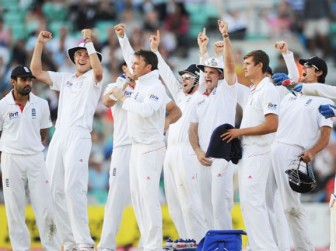As England have not so much leap-frogged as kangaroo-hopped their way to the No.1 position in the International Cricket Council (ICC) Test rankings, the inevitable question arises. Just how strong are they?
The short answer, without indulging in the futile exercise of comparing them with other Goliaths of recent memory, is “very”.
Whether they could have held their own against the all-conquering West Indies teams under Clive Lloyd and Viv Richards, who topped the charts for 15 years, or mighty Australia, who succeeded them for the next decade, is not the point.
 This is a different era and plenty of cricket in diverse conditions across the planet lie ahead for them to come close to matching such dominance. As of now, they are setting standards all those aiming for the top need to achieve. In the past 10 months, they have dismantled three opponents who previously stood above them with an intensity, a self-belief and collective spirit instilled in their teams by Lloyd and carried on by Richards for the West Indies and by Mark Taylor, then Steve Waugh for Australia.
This is a different era and plenty of cricket in diverse conditions across the planet lie ahead for them to come close to matching such dominance. As of now, they are setting standards all those aiming for the top need to achieve. In the past 10 months, they have dismantled three opponents who previously stood above them with an intensity, a self-belief and collective spirit instilled in their teams by Lloyd and carried on by Richards for the West Indies and by Mark Taylor, then Steve Waugh for Australia.
England’s strengths at present are obvious even through our television screens. If behind the scenes, the influence of the leadership of captain Andrew Strauss and coach Andy Flower is less so, it is revealed in the praise of knowledgeable former players.
England now possess the game’s most reliable and prolific opening partnership in Strauss and Alastair Cook, an essential combination as Gordon Greenidge and Desmond Haynes proved in their long association for the West Indies and Matthew Hayden and Justin Langer did for Australia.
Their middle order has the depth and quick-scoring capacity that Richards, Lloyd, Larry Gomes and Richie Richarson gave the West Indies and Ricky Ponting, the Waughs, Mike Hussey and Michael Clarke of Australia during their headiest days.
Matt Prior has become the leading wicket-keeper/batsman in the game, as Jeffrey Dujon and Adam Gilchrist were in their time.
And England’s attack, based on a staff of tall fast and swing bowlers and a quality spinner, has established an aura previously the preserve of the awesome West Indies pace quartet developed by Lloyd and that of Australia’s combination of Glenn McGrath and Shane Warne, with their worthy support casts.
They have won seven of their last 11 Tests against Australia, Sri Lanka and India and are in a good position to win the 12th now in progress at the Oval. On the debit side, they have lost one (to Australia) and drawn three.

In those matches, they have amassed one total over 700, two over 600, four over 500 (including yesterday’s 591 for six ddeclared_, three over 400. In contrast, they had toppled their opponents for under 100 twice, under 200 twice and under 300 ten times.
Their highest was 710 for seven against India at Nottingham; the maximum against them Sri Lanka’s 479 at Lord’s.
As of yesterday, seven of their batsmen had compiled six double-hundreds and 16 single hundreds between them. All told, they had conceded eight hundreds, and no doubles, in reply.
What is more, they repeatedly transform crisis into recovery and control.
Such supremacy has led to unprecedented repercussions in Australia, to whom the loss of the Ashes in successive series was no less than a national disaster.
Cricket Australia immediately took action. It formed an entirely independent committee, headed by Don Argus, a celebrated banking and business executive, to investigate the causes and to make recommendations.
Its report was published during the week. It proposes sweeping changes to the way the game is run with a dramatic restructure, starting with selection, designed to take Australia back to the top of the cricket world within four years.
Chief selector Andrew Hilditch and a member of the panel, no less than an Australia icon, Greg Chappell, were ditched as was coach Tim Nielsen.
India’s turn is bound to come on their return from their unbelievably inept performances in England. Effigies of the perceived culprits, administrators and players alike, are no doubt being fashioned to express the disgust of the millions of passionate fans in the traditional way. Given their unconvincing rise to the top, what we witnessed from them in the Caribbean in June and July and their woeful lack of preparation, India’s shellacking was not surprising. The manner of it was.
For all that, even England’s most avid devotee must appreciate that there are two frontiers to be crossed before they are acknowledged as truly, rather than technically, No.1.
The first is to win a series in the peculiar environment of the sub-continent, a goal that has eluded them since 2001 when they just got home in the darkness against Pakistan in the final Test in Karachi.
The last time they triumphed in India was in 1984-85 under David Gower, the last in Sri Lanka in 2000 when 2-1 victors.
They have three Tests against Pakistan next January and February but, as Pakistan’s political turbulence deems it out of bounds, they will be staged in the Arabian gulf states of Dubai and Abu Dhabi. It is not quite the same as the sub-continent.
Two Tests follow in March in Sri Lanka but the return examination on the slow, turning pitches in India won’t come until November and December next year in four Tests against what will surely be a reconstituted home team seeking vengeance.
The more immediate challenge is in England in the second half of next summer.
It comes in three Tests against South Africa, soon to be No.2 and with the game and the ambition to claim the top spot as their own.
How they go in the intervening Tests against Sri Lanka (three) and Australia (two) at home and New Zealand (three) away will tell whether, by then, they are the strong contenders they seem to be at present.
The West Indies have less grand aspirations, realistically identified by captain Darren Sammy at the end of the recent international season as rising from No.7 at present to No.5 by 2015.
Whatever progress they are making, if any, will be gauged in their forthcoming encounters – in Bangladesh (two Tests) and India (three) in October through December and at home against Australia (three) next March and April.
By then, we should know whether they can at least put up a fight in three Tests in England next May and June or whether they would be in for the humiliation India have gone through these past few weeks.




